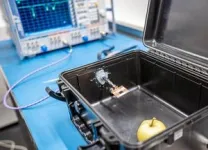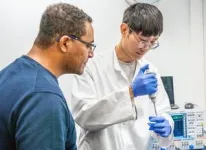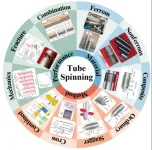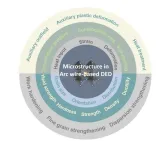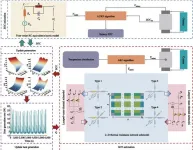(Press-News.org) Although smell has historically played an important role in the fight against diseases such as the plague and tuberculosis, the human nose is generally not sensitive enough to be used as a reliable diagnostic tool.
However, a new artificial ‘nose’ inspired by our sense of smell could now make it possible to detect undiagnosed disease, hazardous gases, and food that is starting to spoil.
And it is all made possible with technology that already exists.
Surrounded by antennas
What do your mobile phone, computer and TV have in common? Antennas.
“We are literally surrounded by technology that communicates using antenna technology,” said Michael Cheffena.
Cheffena is a professor of telecommunications at the Norwegian University of Science and Technology (NTNU) in Gjøvik and believes that this technology can be used for far more than just communication:
“By giving the antennas sensor functions, the existing infrastructure can be used in new areas of application. This has been one of the main motivations for investigating whether antennas can be used for these purposes,” he added.
The simplest solution is often the best
Cheffena explained that previous attempts to create so-called ‘electronic noses’ have not had the advantage of having an existing infrastructure readily available. They have also been affected by a number of other challenges that antenna technology can potentially resolve.
“Other electronic noses can have several hundred sensors, often each coated with different materials. This makes them both very power-intensive to operate and expensive to manufacture. They also entail high material consumption. In contrast, the antenna sensor consists of only one antenna with one type of coating,” said Cheffena.
That must surely come at the expense of accuracy and functionality?
“On the contrary,” said Yu Dang, a PhD research fellow at the Department of Manufacturing and Civil Engineering at NTNU in Gjøvik and the lead author of a recently published research article on the new ‘antenna nose’ in the journal Sensors and Actuators B: Chemical.
The smell of petrol and freshly cut grass
Dang says their sensor distinguishes between the different gases it has been tested on with an accuracy of 96.7 per cent. This is a result that is not only on par with the performance of the best electronic noses to date, but in some areas, it even surpasses them.
To understand how, here's how the antenna nose actually works:
The antenna transmits radio signals at a range of different frequencies into the surroundings. It then analyzes how they are reflected back. The way the signals behave changes based on the gases present, and because the antenna transmits signals at multiple frequencies, the changes create unique patterns that can be linked to specific volatile organic compounds.
Volatile organic compounds are gases that are commonly found in the air. They are characterized by a low boiling point, meaning they tend to evaporate at low temperatures. And even though they can neither be seen nor felt, you will definitely have smelled several of them.
All living organisms, including plants, emit volatile organic compounds, often as a means of protecting themselves from pests or communicating with one another. The smell of freshly cut grass is a well-known example of this.
The gasoline fumes from your lawnmower are another example. Since many of the products we use and the materials we surround ourselves with also emit volatile organic compounds, a large number of gases in various combinations will be present in most environments. This makes the task of distinguishing significant gases from insignificant ones extremely challenging.
Dang explained that it becomes even more difficult when isomers are also added to the mix.
The difficult twins
“Isomers are chemical compounds that have the same molecular formula, but where the atoms are bound together in slightly different ways,” he said.
According to the researchers they are a bit like twins: very similar, yet not identical.
“These compounds have long been a challenge for this type of sensor technology. Even the most sophisticated E-noses consistiing of many different sensors struggle with them,” Dang said.
He is consequently very pleased that their antenna sensor performs so well even on these difficult compounds.
May be able to detect disease
So far, the sensor technology has been tested on impact-damaged fruits and meats of varying ages. By adjusting the algorithms that detect the unique ‘fingerprints’ of the different gases, the researchers believe the technology may also be able to smell diseases.
“Volatile organic compounds enable trained dogs to detect health-threatening changes in blood sugar and diseases like cancer, so the principle is largely the same,” Dang said.
Unlike dogs, however, the antenna sensor does not require months of training or specialized handlers to be used. The basic technology is something you already have in your living room.
Reference: Dang, Y., Reddy, Y. V. M., Cheffena, M. (2024). Facile E-nose based on single antenna and graphene oxide for sensing volatile organic compound gases with ultrahigh selectivity and accuracy. Sensors and Actuators B: Chemical, Volume 419. https://doi.org/10.1016/j.snb.2024.13640
END
Artificial ‘nose’ can sniff out damaged fruit and spoiled meat
The smell of cut grass, or the fumes from refueling your car are all the result of volatile organic compounds. A new approach to antenna technology can actually detect and identify them.
2024-10-21
ELSE PRESS RELEASES FROM THIS DATE:
Tube spinning process: Recent advances and challenges
2024-10-21
Amidst the sustainable evolution of the economy and society, the issues of energy scarcity and environmental degradation have gained increasing prominence, making energy conservation and emission reduction the focal point of societal concern. Within this context, metal tubes fittings, as essential components, wield significant and extensive influence in domains such as aviation, aerospace, and new energy vehicles. Notably, the burgeoning prominence of advanced plastic forming methods, epitomized by the flexible medium forming process of tubes, has garnered ...
Enhancement of material microstructure and properties in Arc wire-based direct energy deposition: A short review
2024-10-21
In recent years, additive manufacturing technology has attracted considerable attention from various stakeholders. Among the different techniques, Arc wire-based direct energy deposition (DED) has experienced a notable increase in development, offering compelling advantages such as cost-effectiveness and high forming efficiency. However, a high deposition rate results in extremely high heat input and temperature inhomogeneity, leading to a deterioration in surface quality, a reduction in material properties, an increase in residual stresses and even distortion and cracking. Consequently, the current research agenda is focused on developing methods to ensure the quality ...
Cloud computing captures chemistry code
2024-10-21
RICHLAND, Wash.—Some computing challenges are so big that it’s necessary to go all in. That’s the approach a diverse team of scientists and computing experts led by the Department of Energy’s Pacific Northwest National Laboratory, along with colleagues from Microsoft and other national laboratories and universities, are taking to democratize access to emerging cloud computing resources.
The effort, outlined in a recent peer-reviewed journal publication, provides a road map to moving scientific computing resources into a sustainable ecosystem that evolves as ...
Novel electrothermal model enables co-estimation of SOC and SOT
2024-10-21
For the main energy storage system for EVs, Li-ion batteries are extensively applied owing to their excellent overall performance The safe and efficient operation of the electric vehicle significantly depends on the accurate state-of-charge (SOC) and state-of-temperature (SOT) of Lithium-ion (Li-ion) batteries. A recent breakthrough study presented by researchers from the Tongji University and Chongqing University introduces a co-estimation of state-of-charge and state-of-temperature for large-format lithium-ion batteries based on ...
Advanced online method for battery model parameter identification: Bias-compensated forgetting factor recursive least squares
2024-10-21
Lithium-ion power battery technology stands out as a pivotal component in advancement of new energy electric vehicles (EVs). Battery parameter identification, as one of the core technologies to achieve an efficient battery management system (BMS), is the key to predicting and managing the performance of Li-ion batteries. A recent breakthrough study presented by researchers from Hebei University of Technology proposes an online battery model parameters identification approach based on bias-compensated forgetting factor recursive least squares. This advanced method is expected to improve the accuracy of parameter identification under different noise.
The ...
Understanding the maturation of white blood cells to find new therapies against lymphoblastic leukaemia
2024-10-21
Over four hundred people, 80% of them being children under 14 years old, will be diagnosed with B-cell Acute Lymphoblastic Leukaemia (B-ALL) next year in Spain, according to the latest projections from the Spanish network of cancer registries (REDECAN). Survival rates for this rapid-growing and aggressive type of blood cancer are high in youth, but fall rapidly with age, especially after 40, stressing the need for new therapeutic alternatives.
B-ALL arises when B-lymphocytes - the antibody producing cells of the immune system - fail to properly mature in the bone marrow, leading to the accumulation of immature progenitors ...
Sexual and gender-diverse individuals face more health challenges during COVID-19: Insights from a large-scale social media analysis
2024-10-21
A new study by researchers at Zhejiang University has highlighted the disproportionate health challenges faced by sexual and gender-diverse (SGD) individuals during the COVID-19 pandemic. By analyzing over 471 million tweets using advanced natural language processing (NLP) techniques, the study reveals that SGD individuals were more likely to discuss concerns related to social connections, mask-wearing, and experienced higher rates of COVID-19 symptoms and mental health issues than non-SGD individuals. The study has been published in the journal Health Data ...
First ever Hispanic thrifty food plan published
2024-10-21
A new study1 has unveiled the Hispanic Thrifty Food Plan (H-TFP), a culturally adapted and affordable diet specifically designed to align with the eating habits of U.S. Hispanic households. The research, led by Adam Drewnowski, PhD, from the University of Washington, used advanced dietary modeling to create a version of the USDA’s Thrifty Food Plan (TFP) that respects the distinctive food patterns of Hispanic communities.
The USDA's Thrifty Food Plan is the foundation for setting benefits under the Supplemental Nutrition Assistance Program (SNAP), but it has not traditionally accounted for the ...
Study reveals how fear memories transform over time, offering new insights into PTSD
2024-10-21
An innovative study, to be published in Nature Communications on October 21, 2024, reveals the mechanism behind two seemingly contradictory effects of fear memories: the inability to forget yet the difficulty to recall. Led by researchers from Sony Computer Science Laboratories, Inc., ATR Computational Neuroscience Laboratories, and the University of Tokyo, the study shows how fear experiences are initially remembered as broad, associative memories, but over time become integrated into episodic memories with a more specific timeline.
The researchers conducted experiments using functional ...
New guideline: Preventing a first stroke may be possible with screening, lifestyle changes
2024-10-21
Guideline Highlights:
Each year in the U.S., over half a million people have a first stroke; however, up to 80% of strokes may be preventable.
The new primary prevention of stroke guideline from the American Stroke Association urges health care professionals to screen people for stroke risk factors, including high blood pressure, elevated cholesterol, high blood sugar and obesity.
Increasing public awareness and knowledge about healthy lifestyle changes, such as smoking cessation, increased physical activity, improved dietary habits and better sleep, may also help people reduce their stroke risk.
The new guideline highlights the American Heart ...
LAST 30 PRESS RELEASES:
Why nail-biting, procrastination and other self-sabotaging behaviors are rooted in survival instincts
Regional variations in mechanical properties of porcine leptomeninges
Artificial empathy in therapy and healthcare: advancements in interpersonal interaction technologies
Why some brains switch gears more efficiently than others
UVA’s Jundong Li wins ICDM’S 2025 Tao Li Award for data mining, machine learning
UVA’s low-power, high-performance computer power player Mircea Stan earns National Academy of Inventors fellowship
Not playing by the rules: USU researcher explores filamentous algae dynamics in rivers
Do our body clocks influence our risk of dementia?
Anthropologists offer new evidence of bipedalism in long-debated fossil discovery
Safer receipt paper from wood
Dosage-sensitive genes suggest no whole-genome duplications in ancestral angiosperm
First ancient human herpesvirus genomes document their deep history with humans
Why Some Bacteria Survive Antibiotics and How to Stop Them - New study reveals that bacteria can survive antibiotic treatment through two fundamentally different “shutdown modes”
UCLA study links scar healing to dangerous placenta condition
CHANGE-seq-BE finds off-target changes in the genome from base editors
The Journal of Nuclear Medicine Ahead-of-Print Tip Sheet: January 2, 2026
Delayed or absent first dose of measles, mumps, and rubella vaccination
Trends in US preterm birth rates by household income and race and ethnicity
Study identifies potential biomarker linked to progression and brain inflammation in multiple sclerosis
Many mothers in Norway do not show up for postnatal check-ups
Researchers want to find out why quick clay is so unstable
Superradiant spins show teamwork at the quantum scale
Cleveland Clinic Research links tumor bacteria to immunotherapy resistance in head and neck cancer
First Editorial of 2026: Resisting AI slop
Joint ground- and space-based observations reveal Saturn-mass rogue planet
Inheritable genetic variant offers protection against blood cancer risk and progression
Pigs settled Pacific islands alongside early human voyagers
A Coral reef’s daily pulse reshapes microbes in surrounding waters
EAST Tokamak experiments exceed plasma density limit, offering new approach to fusion ignition
Groundbreaking discovery reveals Africa’s oldest cremation pyre and complex ritual practices
[Press-News.org] Artificial ‘nose’ can sniff out damaged fruit and spoiled meatThe smell of cut grass, or the fumes from refueling your car are all the result of volatile organic compounds. A new approach to antenna technology can actually detect and identify them.

